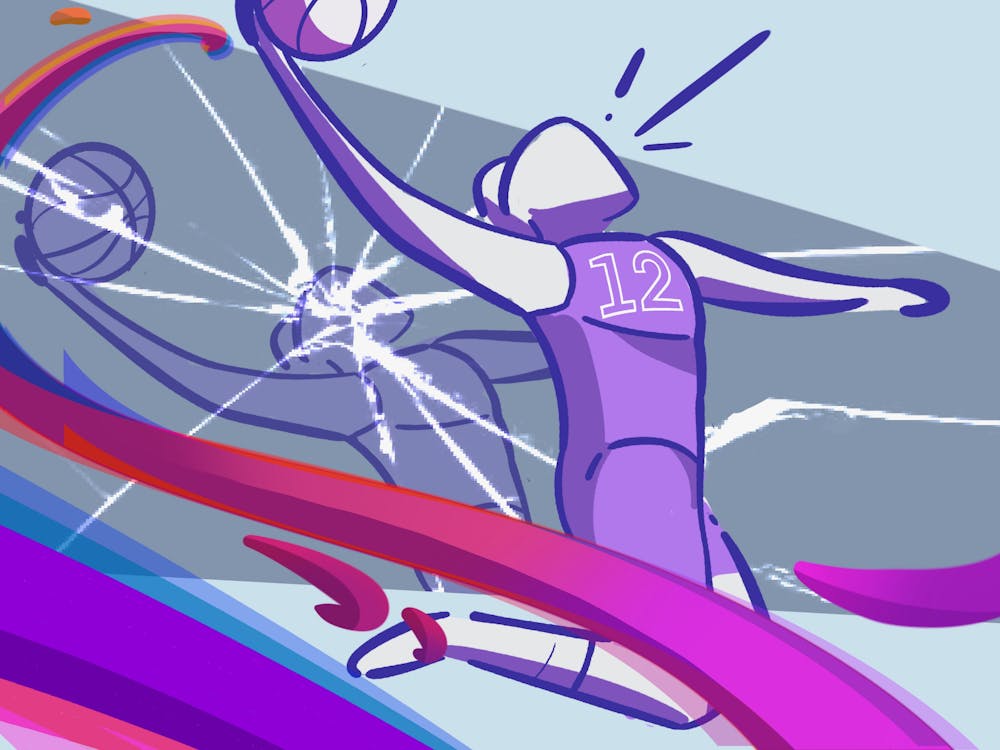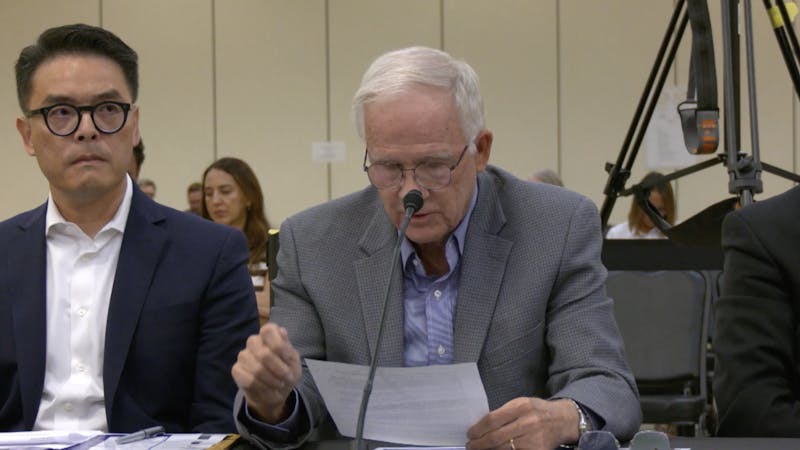After Title IX: Looking back at early women’s sports at Rice

Guillian Paguila / Thresher
In 1977, one of the most smuggled goods at Rice was sandwiches. The perpetrators were the women’s volleyball team, forced to sneak food out of the serveries to accommodate for their practice time at the gym, which overlapped with dinner times. Neither Rice nor the athletics department had made any mealtime provisions for female athletes at the time, according to Helen Travis Savitzky (’80), who was on the volleyball and swim teams during her time at Rice.
“There was always competition for time in the gym … The only time that we could get access to it was during dinner,” Savitzky said. “At that time, dinner was a seated meal that went from time A to time B. There was no other place to go get something to eat. In my sophomore year, they finally started serving sandwiches for lunch, and we would sneak them out so we could get something for dinner.”
Five years earlier, Title IX was passed, prohibiting discrimination in educational programs and thereby giving women equal resources and opportunities in athletics. This change was not instantaneous, though. Savitzky said that strides toward closing the gender gap in athletics was a slow process, happening over the course of many years.
“Some of the people who were seniors when I was a freshman had volleyball, but it was a club sport. It wasn’t an intercollegiate sport. And it changed from being a club sport to an intercollegiate sport … right as I came in,” Savitzky said. “So even though Title IX had passed, Rice didn’t just jump on board in 1972.”
Before Title IX had fully taken effect, the starkest disparity between male and female athletics at Rice was the sheer lack of resources allotted to the latter. It didn’t stop at smuggled sandwiches. According to Savitzky, funding for equipment and transportation for female athletics was little-to-nonexistent.
“We played other schools in Texas,” Savitzky said. “We got there in passenger vans. We didn’t fly anywhere, [it] didn’t matter how long the drive was. We stayed four [people] to a room in hotels that you wouldn’t set foot in today. We ate at places where I wouldn’t even stop to get a glass of water. I mean, there was no money.”
This wasn’t the case for male athletics, where plenty of funding already existed. James Disch, the former coach for intercollegiate women’s volleyball and basketball teams, said that funding for men’s team cemented them as a fully functioning program. The same couldn’t be said for the women’s team, though.
“The men’s program was fully funded. There [were] scholarships, there were paid coaches. It was a program,” Disch said. “The only thing that made the women’s program intercollegiate was the fact that we were playing other people. It was really glorified intramurals.”
Denise Bostick Demery (’80), who played volleyball for Rice as a walk-on in the late 1970s, most recalled the differences in structure for male and female athletics, which typically demanded that female teams orient themselves around the male teams.
“The men had great trainers, they had all this equipment, they had the preferred practice times,” Demery said. “We worked our times around their practice times and our game schedules around their game schedules … I remember I sprained my ankle, and I had to get assistance from a trainer, but I had to go into the male training room to get assistance there, and I had to use their equipment.”
By this point, scholarship money for female athletes was barely in existence, with significant disparities in the amount of funding offered to male and female athletes. Often, Demery said she noticed that talented female athletes were faced with expenses that their male peers had covered by scholarships.
The introduction of adequate scholarships in the 1978-79 school year had a twofold impact: it decreased barriers to athletic participation and improved camaraderie across women’s teams, according to Savitzky.
“The thing that seems different to me, retrospectively, is how close the teammates are to each other [now]. We didn’t really have that,” Savitzky said. “We were all Rice students first and athletes second … so we weren’t very close to each other. Now that there are scholarships, and you are recruited as a scholarship athlete, [athletes] have an obligation to the team as well.”
Although Title IX was key in expanding funding and resources for women’s athletics, it also had unintended drawbacks for female athletes, according to Disch.
“The interesting thing that happened at that time, is when they started paying coaches, a lot of the women’s coaches — not at Rice, but [at] other places — lost their jobs because there were men [who] were better qualified that were now looking for these jobs,” Disch said. “[Title IX] had some kind of unanticipated cost consequences early on. A lot of the women would prefer to play for a male coach, because they felt he was better qualified and could coach them better than the women.”
In the decades since Title IX’s passing, Savitzky has also noticed that tangible student support for athletics now exists, which wasn’t necessarily true during her time as an athlete.
“Students at Rice events were few and far between,” Savitzky said. “They studied. They were all nerds. Athletics just wasn’t part of their vernacular … You got kids out there who couldn’t walk and chew gum at the same time.”
Reflecting on her own time at Rice, Demery said that the passing of Title IX helped validate her — and other female athletes’ — contribution to the university, paving the path for future athletes down the road.
“[Title IX] forced universities and schools to recognize [that] female athleticism is important … and they need the same resources,” Demery said. “I mean, we needed a new volleyball net, we needed basketballs, we needed new volleyballs, not the old ones that they had for four years.”
As the athletes from Rice’s past look to the future of the university, they said they recognized the immense strides that have been made toward building equal opportunities for female athletes.
“I was able to meet a lot of women that have been in athletics at the inauguration of President DesRoches. They came up to me … and told me about how wonderful things have become [in Rice athletics],” Leila Freeman Alguacil (’79) said. “So I would say… keep going forward.”
More from The Rice Thresher

Rice announces Chao College as 12th residential college
Rice announced that the 12th residential college will be named Ting Tsung and Wei Fong Chao College Aug. 19. The college, set to open in fall 2026, will contain nearly 300 on-campus beds.
Dining access fund announced following on-campus unlimited meal swipes
Rice announced new food assistance programs on Tuesday to account for the controversial change in the on-campus meal swipe plan.

Rice disaster prediction model discussed at hearing on deadly Central Texas floods
The House and Senate Select Committees on Disaster Preparedness and Flooding held a hearing on July 31 in Kerrville to address the deadly July 4 flooding in Central Texas. The flooding along the banks of the Guadalupe River killed 108 people, including 37 children. In the charged hearing, Texas lawmakers and flood survivors criticized the local response to the disaster.


Please note All comments are eligible for publication by The Rice Thresher.